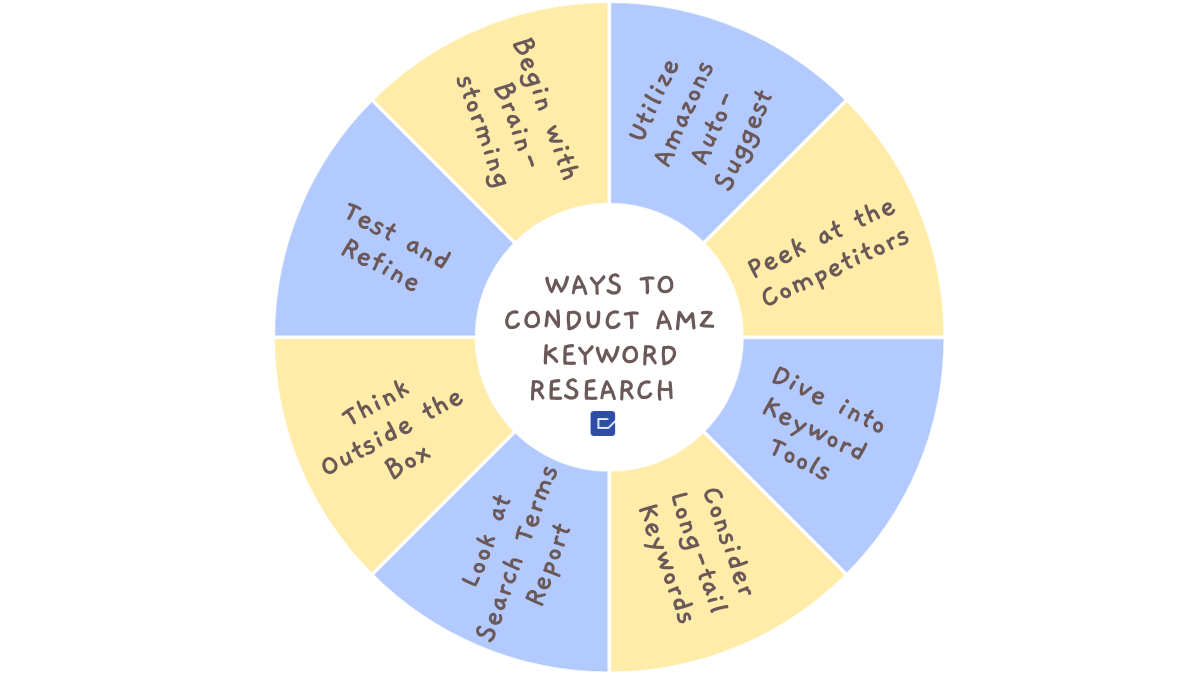Have you ever wondered how some Amazon sellers manage to rank so highly while others have a much harder time getting their products seen? Every successful Amazon listing has a carefully planned and executed advance keyword research for Amazon PPC. There are millions of products on the platform, so how can you find the gems of keywords that would make your products stand out?
Good news, then! This blog will delve deeply into the methods and resources top sellers employ to zero in on those potentially market-altering keywords. With any luck, by the time you reach the conclusion of this blog, you’ll have a crystal clear plan of action to take over your niche and increase your sales.
Why do people talk more about advanced keyword research for Amazon PPC?
Before we get into it, though, have a look at the PPC worries that Amazon sellers have listed.
There has been a lot of talk across different platforms concerning the high cost of Amazon PPC. Concern that Amazon PPC is eating up too much of their profits is shared not just by newer sellers but even by those at the top of the industry.
This is where the plot truly kicks off.
Previously, Google Ads have been around longer than any other form of search engine marketing. In the past, this ad received the highest rates. People also used Google ads to drive customers to their Amazon product pages. However, things are very different now.
Because Amazon PPC marketing is so much more expensive than Google AdWords, discussions on Amazon PPC keyword research have been frequent. The news is terrific for Amazon sellers. The following figure serves as an example of this expense:
In April 2023, the average CPC for advertisements on Amazon was $1.25, whereas on Google it was only $0.71.
With this knowledge alone, you can receive more clicks from Google while spending less on ads than you would on Amazon. Now, hear a piece of truly astounding news. Amazon sees 1 sale from Google as equal to 4 sales from Amazon PPC, despite the fact that Amazon advertisements are more expensive.
This is why Amazon DSP is gaining popularity and why sellers are experimenting with strategies other than Amazon PPC ads to boost their listings’ exposure. This is where the advance keyword research for Amazon PPC begins.
One wrong keyword can ruin your whole PPC campaign
This is a harsh fact. One wrong keyword can impact your PPC campaign drastically. If you have the wrong keyword, it’s like driving with a faulty GPS—you might end up in the middle of nowhere and waste a lot of fuel (money) in the process. We can define “wrong keywords” in many ways.
Wrong keyword scenario 1
Don’t use the primary keyword or ‘root’ keyword. Instead, find longer-tail keywords that describe your product best but also contain the rool keyword within them.
Let’s say you are selling “garlic pres”. This root keyword can cost $10 per click or more. So, use the keyword ‘stainless steel garlic press for professional chefs’. Avoid making an educated estimate. Your keyword research should consist of deep research. Put your primary keyword aside for the moment, and instead compile a list of highly relevant long-tail keywords that receive adequate but not overwhelming search volume.
Wrong keyword scenario 2
Don’t use the super-generic keyword.
Let’s say you are selling “leather handbags,” and if you choose the broad match, don’t use “leather handbags,” but rather stay a bit specific.
Your entire PPC campaign might be ruined by selecting the wrong term. We’ve covered the most typical situations in which our customers frequently weep. There may be plenty of additional examples. First, though, let’s talk about the things we need to do and the mistakes we need to avoid in order to achieve top keyword rankings in Amazon PPC. It will help you a lot to get rid of every PPC problem.
Must-to do things in Amazon PPC for keyword ranking
We have explained in the following points about certain things that most of our clients usually face but they don’t know.
Keyword relevancy is the key
Select the right keyword that best fits the user’s needs. Take, for example, a “vitamin D” product you intend to market. Use the term “Vitamin D supplements” instead of just “Vitamin D.” This is because “Vitamin D” is meant to provide information and benefits, but you are selling Vitamin supplements.
To put it simply, when you launch a PPC campaign on Amazon, you’re telling the Amazon, “Hey, show my product ad when someone searches for this keyword.” Choose a keyword that relates to your products, and you might just strike gold. Customers are looking for what you’re offering, so they might be compelled to click on your ad and, who knows, even make a purchase. But if your keyword choice is wrong, it’s like the DJ playing music from the incorrect era: nobody will care.
Let’s take another example.
One of the products you’re offering is a “vegan leather laptop bag.” A related keyword could be “vegan laptop bag” or “cruelty-free laptop bag.” But suppose you decide to use a less specific term, like “laptop.” Although “laptop” is related, it covers far too many different types of devices. Someone searching for a “laptop” is probably not interested in purchasing a bag, but rather a laptop. So, it’s money down the drain every time people see your ad and either don’t click on it or click on it and then leave without making a purchase.
Keyword have enough Amazon traffic
The main thing you do when setting up your Amazon PPC campaign is choose a “location” (or keyword) where you want your ads to show up. If not enough people are looking for that keyword on Amazon, it’s like throwing a party in the middle of nowhere.
So, before you start using a set of keywords, make sure you check their traffic volume using the appropriate tools. Because you won’t get any exposure, clicks, or conversions with a low-traffic term. Spending money on this is a bad idea.
Let’s look at an example:
Let’s say you’re offering a unique “blueberry lavender smoothie mix.” You might even think, “Hey, maybe people are specifically looking for this combo!” because you see that people are loving both fruits smoothie mix. As a result, “blueberry lavender smoothie mix” becomes your primary keyword. Although highly relevant, it may not be a popular keyword. Therefore, it’s possible that not many people will see your ad.
Choose a keyword like “fruit smoothie mix,” which is more broad and hence more likely to provide results. It’s possible that not all people who search for “fruit smoothie mix” will want the blueberry-lavender mix, but because there are so many people looking, your product will probably get more clicks and views. This is another example of advance keyword research for Amazon PPC.
Keyword traffic on Google (Keyword planner)
There’s little doubt that Google is the most popular search engine worldwide. Google traffic for a keyword is an indication of how much demand there is in that keyword and the topic or product it relates to. If you take a look at the search volume for a particular keyword on Google, you can get an idea of what people are interested in. Google’s keyword planner can help you get a ballpark figure, but knowing for sure if a keyword gets enough searches is important.
Product listings must be well-optimized
This is very important to note, but sellers skip it very often. Please keep in mind that listing quality is the first thing that you have to look at before moving to Amazon PPC. Believe me, for most of the Amazon PPC clients that I have handled, their listings were not well optimized with the proper keywords, and just when we optimized the listings, PPC costs also got reduced.
So, most of the sellers are complaining that their Amazon ads are getting enough impressions, but the conversion is low. In such cases, I believe 70% of the time there is a product listing optimization problem. For your clarity, listing optimization is not just about inserting high-volume keywords, quality images, or a good description; rather, it’s also about “whether you have a Me-Too product?” or “whether your market is saturated or not?” or “what is the value that you are providing as compared to your competitors?”
So,
- If the market is saturated but your product is different and provides value, there could be ways of getting conversions from PPC ads by using different keywords.
- If the market is saturated and your product is “Me-too”, there is no way of liquidating the inventory other than spending and losing money on Amazon PPC. Because it will eat up your whole profit.
We’ll give you real-life example later in this blog. Keep reading for that.
How do you conduct the best Amazon keyword research?
There are many ways to conduct advance keyword research for Amazon PPC. Let me give you just a brief overview of each way, and then we will move on to the best way that we have been utilizing at eComFist for our clients.
1-Start with some creative thinking
Like any good adventure, you should start with what you already know. Ponder what you have to offer. What search terms would you use on Amazon to find more keywords? Get started writing down those keywords.
2-Make use of Auto-Suggest on Amazon
Have you ever noticed that the Amazon search box provides suggestions as you type? That’s Amazon’s way of suggesting related search terms. Just go ahead and search for your products and see what comes up. It sounds like Amazon is trying to tell you something in confidence.
3-Peek at the competitors
Now, put yourself in the role of a spy. Look at what your competitors are offering in their Amazon storefront. What phrases are they employing to describe their product titles, bullet points, and products? Use them as a jumping off point instead of a template for your own list.
4-Dive into keyword tools
Tools like Jungle Scout, Helium 10, and Sonar are wonderful resources for finding untapped keyword opportunities. In this treasure hunt, they serve a similar function to metal detectors.
5-Don’t forget about long-tail keywords
These are the sentences with three or more words that are very specific. You can’t just say “shoes,” but rather “women’s red ballet flats.” Although they may not receive as many searches, these terms are frequently more likely to result in a sale.
6-Look at search terms report
Amazon gives a search phrase report for those who have previously performed PPC campaigns. It’s like finding out exactly how people discovered (and clicked on) your ad. You can add the ones that catch you by surprise to your list of keywords.
7-Don’t limit yourself
It’s not all about using common keywords. Perhaps you’re selling a tool for the kitchen that would come in handy for those who enjoy DIY projects. Sometimes, when you broaden your perspective, you find something that works out quite well for you.
8-Put it to the Test
The next step is to use the collected keywords in your PPC campaign. But keep in mind that the e-commerce landscape is ever-shifting. You should analyze your PPC results on a regular basis to determine which keywords are producing the best results and which are wasting your money.
Read More: Is it worth it for you to sell on Amazon in 2023
How do we conduct advance keyword research for Amazon PPC at eComFist?
Remember that for doing keyword research, we don’t need assumptions but a bit of common sense with deep-dive research. How could it be possible?
It could be possible with a method that we usually follow. Look, you can find tons of keywords with good search volume related to your products. You can check its traffic and volume via different tools, do competitor analysis, and search on Google, but how could you know which keyword will perform? Whether to use long-tail or short-tail keywords
This knowledge comes from testing keywords.
This is how I do keyword research and run my Amazon PPC ads.
- To do the competitor analysis, I use the “Cerebro” tool of Helium 10 and put 10 ASINs of my competitors.
- I usually do the analysis of each keyword and check which product is getting the top ranking on that keyword.
- I separate exact phrase keywords from long-tail keywords with good volume.
- Then I run the “Magnet” tool in Helium 10 and check all the keyword suggestions.
- Now I have a list of keywords with deep dive research.
- I further filter out that list on the basis of relevancy, volume, phrase match, exact match, and product targets.
- Then I make the Amazon PPC strategy. There are different ways of doing so. Let’s say I run 1 PPC campaign with an exact phrase match with my primary keyword “garlic press stainless steel”, I put the same keyword as the negative keyword in the phrase match.
- In the same way, I run other PPC manual campaigns and keep adjusting bids. I prefer “dynmic bid-down only”. Sometimes, I make different ad groups with different keywords and test them.
- After a week, I evaluate the campaign’s performance based on two factors: the number of sales made and an ACoS of 20% or more. If the campaign meets both criteria, I will increase the budget and closely monitor its progress.
- In 90% of cases, my campaigns usually remain successful.
And, ta da! You may successfully direct your PPC campaign with mistakes, keyword research, PPC strategies, and testing if you are patient, diligent, and creative. Always keep in mind the importance of testing different strategies, learning from your mistakes, and making adjustments.
Last but not least…
Advance keyword research for Amazon PPC is not the straight path to doing research. You have to explore different ways of doing research. I have mentioned those ways above. It’s important not to make assumptions. Stick to the sheer data. Make decisions based on different Amazon KPIs. Go with strategies for running PPC campaigns, and then evaluate the results with common sense. Don’t get frustrated over the bad results at the start. Keep changing the keywords until you don’t get the results.
If your assessment is not critical, hire the Amazon advertising service. Make use of their expertise and experience.















